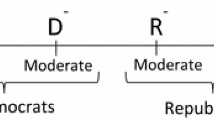Abstract
The median-voter result, and the issue of stability in electoral competition generally, have been examined from a number of different perspectives. Out of all these examinations, however, only a few focus on institutional variables. This essay demonstrates that the median-voter result is robust under a significant institutional change that entails altering the basic assumption of single-member districts. After developing a model of electoral competition in a two-member, first-two-past-the-post district, I show that, if there are three candidates, the set of Nash equilibria is the set of strategy triples (x 1, x 2, x 3), with x 1 = x 2 = x 3 = x*, and such that x* lies between the quantiles of order 1/3 and 2/3. If there are four candidates, I show that a unique Nash equilibrium exists with all candidates adopting a position at the medianvoter's ideal point.
Similar content being viewed by others
References
Aldrich, J.H. (1983). A spatial model with party activists: Implications for electoral dynamics. Public Choice 41: 63–101.
Aranson, P.H. and Ordeshook, P.C. (1972). Spatial strategies for sequential elections. In R.G. Niemi and Weisberg, H.F. (eds.), Probability Models of Collective Decision-Making, Columbus: Merrill.
Aranson, P.H., Hinich, M.J., and Ordeshook, P.C. (1973). Campaign strategies for alternative election systems: Candidate objectives as an intervening variable. In H.R. Alker, et al. (eds.) Mathematical Approaches to Politics, Amsterdam: Elsevier.
Black, D. (1958). The Theory of Committees and Elections. Cambridge: Cambridge University Press.
Brams, S. and Fishburn, P. (1978). Approval voting. American Political Science Review 72: 831–847.
Council of State Governments. (1980). The book of the states, 1980–1981. Lexington: Council of State Governments.
Cox, G.W. (1984). Strategic electoral choice in multi-member districts: Approval voting in practice? Forthcoming in American Journal of Political Science 28 (November).
Downs, A. (1957). An economic theory of democracy. New York: Harper and Row.
Hinich, M.J. and Ordeshook, P.C. (1969). Abstentions and equilibrium in the electoral process. Public Choice 7 (Fall: 81–106).
Klain, M. (1955). A new look at constituencies: The need for a recount and reappraisal. American Political Science Review 49: 1105–1119.
Kramer, G.H. A dynamical model of political equilibrium. Journal of Economic Theory 16 (December): 310–334.
MacRae, D. and Sawyer, J. (1962). Game theory and cumulative voting in Illinois: 1902–1954. American Political Science Review 56: 936–946.
McKelvey, R. (1979). General conditions for global intransitivities in formal voting models. Econometrica 47 (September): 1085–1112.
McKelvey, R.D. and Wendell, R.E. (1976). Voting equilibria in multi-dimensional choice spaces. Mathematics of Operations Researc 1 (May): 144–158.
Mitchell, J.C. (1976). Electoral strategy under open voting: Evidence from England, 1832–1880. Public Choice 28 (Winter): 17–35.
Petry, F. (1982). Vote-maximizing versus utility-maximizing candidates: Comparing dynamic models of bi-party competition. Quality and Quantity 16: 507–526.
Plott, C.R. (1967). A notion of equilibrium and its possibility under majority rule. American Economic Review 57: 787–806.
Shepsle, K.A. (1972). The strategy of ambiguity: Uncertainty and electoral competition. American Political Science Review 66: 555–568.
Tullock, G. (1981). Why so much stability? Public Choice 37: 189–202.
Author information
Authors and Affiliations
Additional information
I would like to thank Howard Rosenthal, Peter Aranson and an anonymous referee for their helpful comments.
Rights and permissions
About this article
Cite this article
Cox, G.W. Electoral equilibrium in double member districts. Public Choice 44, 443–451 (1984). https://doi.org/10.1007/BF00119692
Issue Date:
DOI: https://doi.org/10.1007/BF00119692




